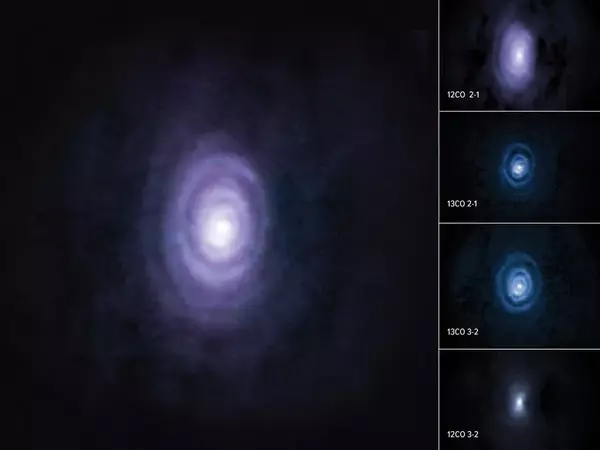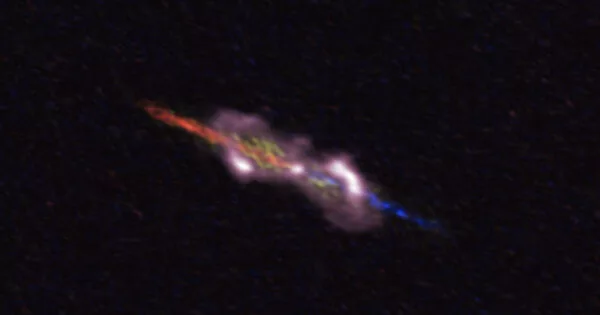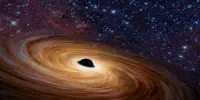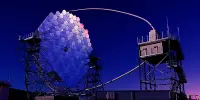V Hydrae (V Hya) scientists have witnessed the star’s mysterious death throes in unprecedented detail. The team discovered six slowly-expanding rings and two hourglass-shaped structures caused by the high-speed ejection of matter into space using the Atacama Large Millimeter/submillimeter Array (ALMA) and data from the Hubble Space Telescope (HST). The study’s findings were published in The Astrophysical Journal.
V Hya is a carbon-rich asymptotic giant branch (AGB) star located approximately 1,300 light-years from Earth in the constellation Hydra. More than 90% of stars with masses equal to or greater than the Sun evolve into AGB stars as the fuel required to power nuclear processes is depleted. Among these millions of stars, V Hya has piqued scientists’ interest due to its so far unique behaviors and features, such as extreme-scale plasma eruptions that occur roughly every 8.5 years and the presence of a nearly invisible companion star that contributes to V Hya’s explosive behavior.
“Our study dramatically confirms that the traditional model of how AGB stars die — through the mass ejection of fuel via a slow, relatively steady, spherical wind over 100,000 years or more — is at best, incomplete, or at worst, incorrect,” said Raghvendra Sahai, an astronomer at NASA’s Jet Propulsion Laboratory, and the principal researcher on the study.
“A close stellar or substellar companion is very likely to play a significant role in their deaths, and understanding the physics of binary interactions is both important in astrophysics and one of its greatest challenges. In the case of V Hya, the presence of its six rings, as well as the high-speed outflows that are causing the star’s miraculous death, is due to the interaction of a nearby and a hypothetical distant companion star.”
Our study dramatically confirms that the traditional model of how AGB stars die — through the mass ejection of fuel via a slow, relatively steady, spherical wind over 100,000 years or more — is at best, incomplete, or at worst, incorrect.
Raghvendra Sahai
Mark Morris, an astronomer at UCLA and a co-author on the study, added, “V Hydra is in the process of losing its atmosphere, and thus most of its mass, as most late-stage red giant stars do. Much to our surprise, we discovered that the matter in this case is being expelled as a series of outflowing rings. This is the first and only time anyone has seen gas ejected from an AGB star flowing out in the form of a series of expanding’smoke rings.’
The six rings have expanded outward from V Hya over the course of roughly 2,100 years, adding matter to and driving the growth of a high-density flared and warped disk-like structure around the star. The team has dubbed this structure the DUDE, or Disk Undergoing Dynamical Expansion.
“The end state of stellar evolution — when stars undergo the transition from being red giants to ending up as white dwarf stellar remnants — is a complex process that is not well understood,” said Morris. “The discovery that this process can involve the ejections of rings of gas, simultaneous with the production of high-speed, intermittent jets of material, brings a new and fascinating wrinkle to our exploration of how stars die.”

Sahai added, “V Hya is in the brief but critical transition phase that does not last very long, and it is difficult to find stars in this phase, or rather ‘catch them in the act. We got lucky and were able to image all of the different mass-loss phenomena in V Hya to better understand how dying stars lose mass at the end of their lives.”
In addition to a full set of expanding rings and a warped disk, V Hya’s final act includes two hourglass-shaped structures – as well as an additional jet-like structure – that expand at speeds of over 500,000 miles per hour (240 km/s). Large hourglass structures have previously been observed in planetary nebulae, including MyCn 18 (also known as the Engraved Hourglass Nebula), a young emission nebula located approximately 8,000 light-years from Earth in the southern constellation of Musca, and the more well-known Southern Crab Nebula, an emission nebula located approximately 7,000 light-years from Earth in the southern constellation Centaurus.
Sahai said, “We first observed the presence of very fast outflows in 1981. Then, in 2022, we found a jet-like flow consisting of compact plasma blobs ejected at high speeds from V Hya. And now, our discovery of wide-angle outflows in V Hya connects the dots, revealing how all these structures can be created during the evolutionary phase that this extra-luminous red giant star is now in.”
Due to both the distance and the density of the dust surrounding the star, studying V Hya required a unique instrument with the power to clearly see matter that is both very far away and also difficult or impossible to detect with most optical telescopes. The team enlisted ALMA’s Band 6 (1.23mm) and Band 7 (.85mm) receivers, which revealed the star’s multiple rings and outflows in stark clarity.
“The processes occurring at the end stages of low mass stars, particularly during the AGB phase, have long fascinated and perplexed astronomers,” said Joe Pesce, an astronomer and NSF program officer for NRAO/ALMA. “ALMA’s capabilities and resolution are finally allowing us to witness these events with the extraordinary detail required to provide some answers and enhance our understanding of an event that occurs to the majority of the stars in the Universe.”
The incorporation of infrared, optical, and ultraviolet data into the study created a complete multi-wavelength picture of what could be one of the best shows in the Milky Way, at least for astronomers, according to Sahai. “Each time we observe V Hya with new eyes, it becomes more and more like a circus, with an ever-increasing variety of impressive feats. V Hydrae has impressed us with its numerous rings and acts, and because our own Sun may one day suffer a similar fate, we are paying close attention.”
















